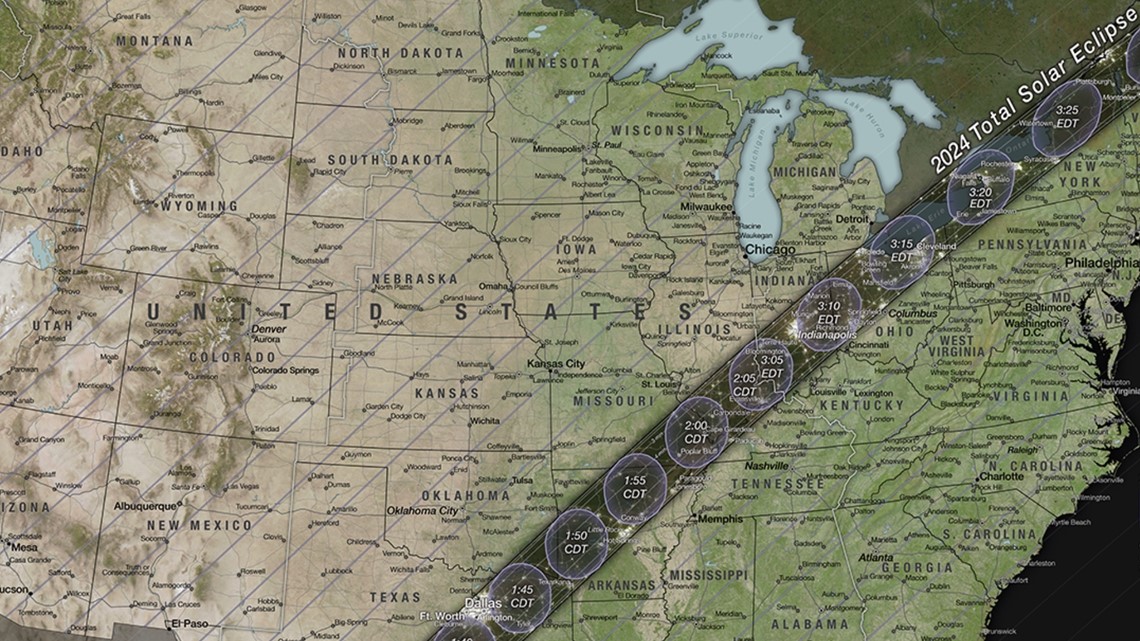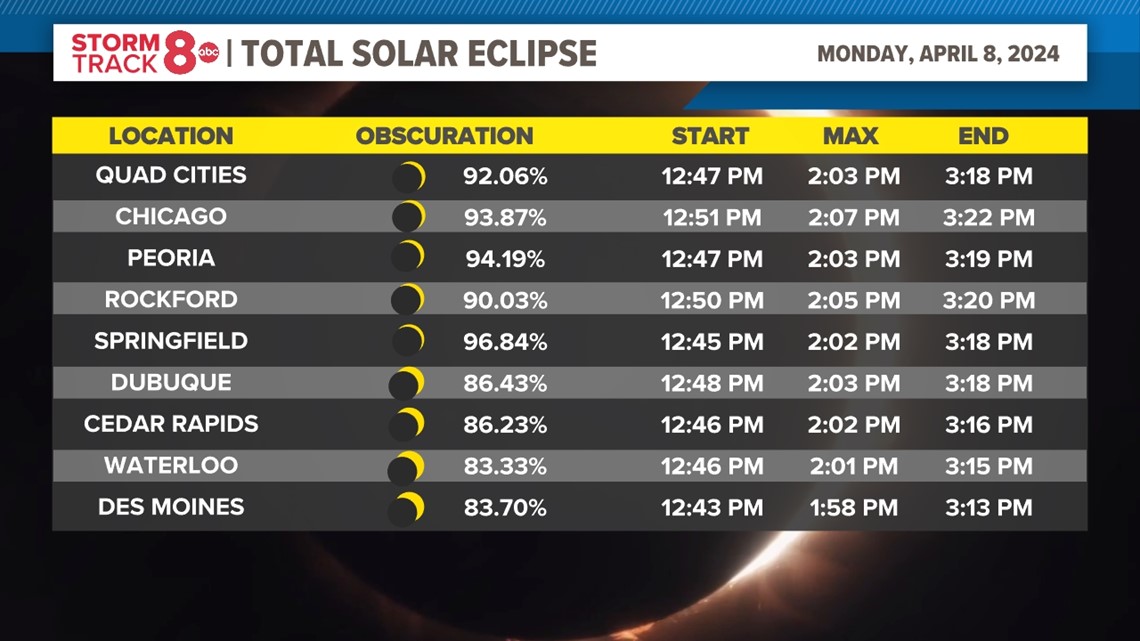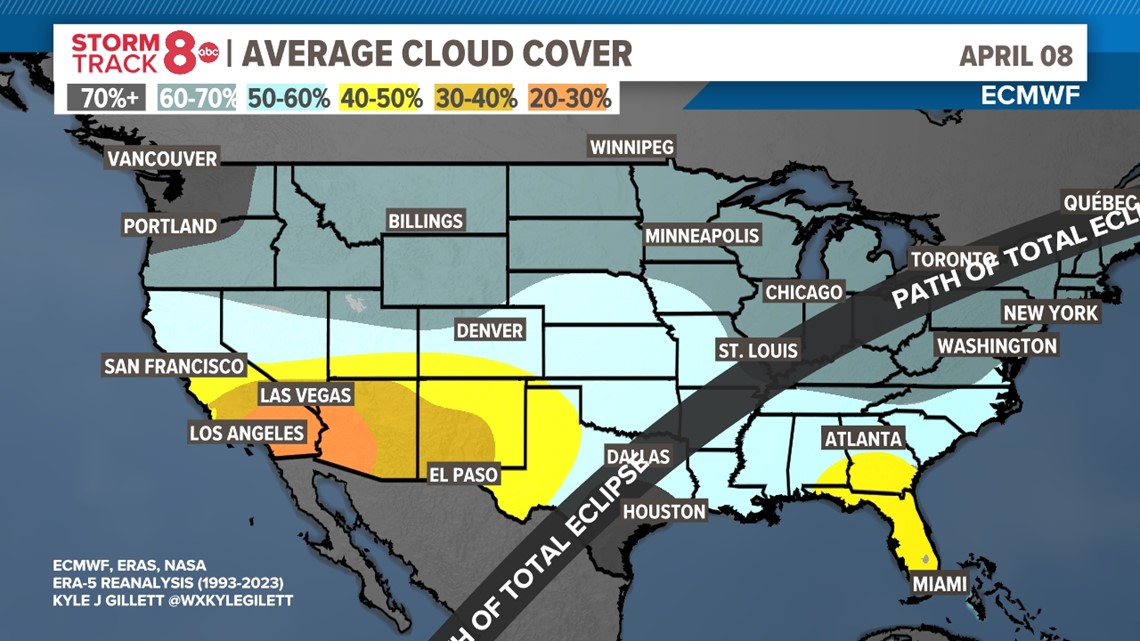MOLINE, Ill. — Live Solar Eclipse Coverage: The Great American Eclipse is today, April 8. Join us from 1-3 p.m., when News 8 will have live eclipse coverage on our website, the News 8+ streaming app, the News 8 mobile app and MyTV 8-3.
The sun is about to pull another disappearing act across North America, turning day into night during a total solar eclipse.
The peak spectacle on April 8 will last up to 4 minutes and 28 seconds in the path of total darkness — twice as long as the total solar eclipse that dimmed U.S. skies in 2017.
What is the 2024 total solar eclipse path?
This eclipse will take a different and more populated route, entering over Mexico’s Pacific coast, dashing up through Texas and Oklahoma, and crisscrossing the Midwest, mid-Atlantic and New England, before exiting over eastern Canada into the Atlantic.
An estimated 44 million people live inside the 115-mile-wide path of totality stretching from Mazatlán, Mexico to Newfoundland; about 32 million of them are in the U.S., guaranteeing jammed roads for the must-see celestial sensation. The path of totality will cross through much of southern Illinois — just about five hours from the Quad Cities region.


Who will be able to see the eclipse?
Practically everyone on the continent can catch at least a partial eclipse. The farther from the path of totality, the smaller the moon’s bite will be out of the sun. In Seattle and Portland, Oregon, about as far away as you can get in the continental U.S., one-third of the sun will be swallowed.
Will the eclipse be visible in the Quad Cities?
While the Quad Cities won't experience 100% totality, the region is close enough to the path that it'll get pretty close. The eclipse will reach 91% totality at its peak.
While the sun will not be completely covered by the moon, a partial solar eclipse will still slightly darken skies and put on a celestial spectacle. Totality is the only stage of an eclipse that can be viewed with the naked eye. So those watching from the QCA must be wearing eclipse glasses at all times.
What time will the eclipse be?
The partial eclipse will start around 12:47 p.m. and peak at 2:03 p.m. The eclipse will last until roughly 3:18 p.m.


What's the weather looking like for April 8?
Of course, totality is only one part of the equation in viewing the 2024 solar eclipse. Weather conditions also play a role, as dense cloud coverage could block the action.
News 8 Meteorologist Andrew Stutzke used past sky condition data from 1993 through 2023 and advanced computer modeling to find out where the skies might give eclipse observers some problems. This includes areas in the Pacific Northwest, Midwest and Northeast, where an active storm track typically lies.
Luckily, the timing of the eclipse is somewhat on our side, starting around 12:47 p.m. and wrapping up near 3:18 p.m. This time of day, depending on the weather pattern in play, generally tends to favor more mixing of the air, including dry air to either clear clouds and fog out, or keep most of them at bay until later in the afternoon.


When is the next total solar eclipse?
Full solar eclipses occur every year or two or three, often in the middle of nowhere like the South Pacific or Antarctic. The next total solar eclipse, in 2026, will grace the northern fringes of Greenland, Iceland and Spain.
North America won’t experience totality again until 2033, with Alaska getting sole dibs. Then that’s it until 2044, when totality will be confined to Western Canada, Montana and North Dakota.
There won’t be another U.S. eclipse, spanning coast to coast, until 2045. That one will stretch from Northern California all the way to Cape Canaveral, Florida.
Aside from Carbondale, Illinois, in the crosshairs of both the 2017 and 2024 eclipses, it usually takes 400 years to 1,000 years before totality returns to the same spot, according to NASA’s eclipse program manager Kelly Korreck.

